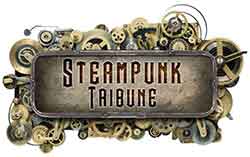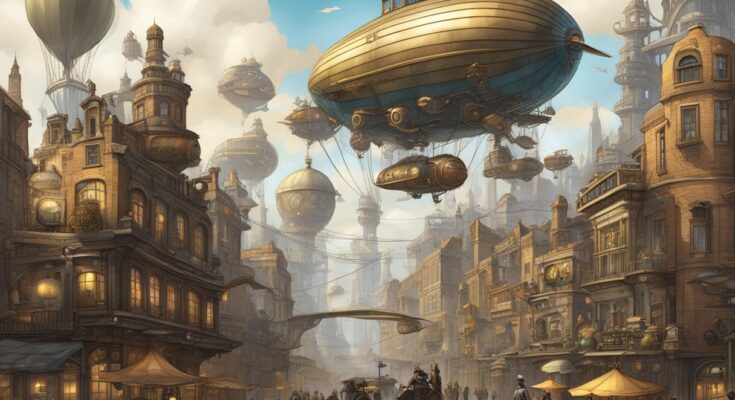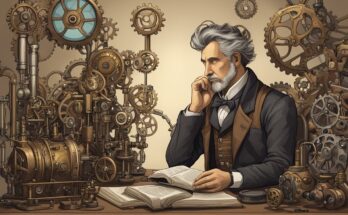Steampunk is a subgenre of science fiction that has gained popularity in recent years. It is characterized by its retro-futuristic technology and aesthetics, which are inspired by the 19th century industrial steam-powered machinery. The term “steampunk” is derived from the words “steam” and “punk,” and it usually involves an alternate world where steam power is still widely used.

Steampunk is often associated with the Victorian era in England, but it can also be set in other time periods and locations. The genre is known for its unique fashion, which often includes corsets, top hats, goggles, and other Victorian-inspired clothing. Steampunk stories typically involve adventure, mystery, and romance, and they often feature airships, clockwork robots, and other fantastical inventions.
When it comes to science fiction, steampunk is just one subgenre among many. Science fiction is a broad category that encompasses a wide range of stories and themes. However, steampunk has a unique appeal that sets it apart from other science fiction subgenres. Its blend of history, technology, and fantasy creates a world that is both familiar and fantastical, and its emphasis on adventure and exploration makes it a popular choice for readers and viewers alike.
Understanding Steampunk and Sci-Fi
Steampunk is a subgenre of science fiction that incorporates retrofuturistic technology and aesthetics inspired by 19th-century industrial steam-powered machinery. It is an anachronistic genre that imagines a world where steam power is the primary source of energy and technology. Steampunk often takes place in an alternative history, where the Industrial Revolution took a different turn, resulting in a society that is both futuristic and Victorian.
Sci-fi, on the other hand, is a broader genre that encompasses many subgenres, including steampunk. It is a form of speculative fiction that explores the impact of science and technology on society and culture. Sci-fi often imagines worlds that are different from our own, either in the present or future.
Steampunk and sci-fi share many similarities, including their focus on technology, alternate histories, and futuristic societies. However, steampunk is a more specific subgenre that is defined by its anachronistic technology and neo-Victorian culture. Sci-fi, on the other hand, is a more general genre that encompasses many subgenres, including steampunk.
Both steampunk and sci-fi have many subgenres, each with its own conventions and aesthetics. Some of the most well-known sci-fi subgenres include cyberpunk, space opera, and dystopian fiction. Steampunk has also spawned many subgenres, including clockpunk, gaslamp fantasy, and dieselpunk.
In conclusion, steampunk and sci-fi are two related genres that explore the impact of technology on society and culture. Steampunk is a subgenre of sci-fi that is defined by its anachronistic technology and neo-Victorian culture, while sci-fi is a broader genre that encompasses many subgenres, including steampunk. Both genres have many subgenres, each with its own conventions and aesthetics.
Historical Context and Precursors

Steampunk is a subgenre of science fiction that takes place in an alternative version of the 19th century. It is characterized by its unique blend of Victorian-era aesthetics and advanced steam-powered technology. The term “steampunk” was coined by K.W. Jeter, a science fiction author, in 1987.
Many steampunk authors draw inspiration from the works of Jules Verne and H.G. Wells. These two authors were instrumental in the development of science fiction as a genre, and their works helped to shape the popular perception of science and technology during the 19th century. Verne’s novels, such as “Journey to the Center of the Earth” and “Twenty Thousand Leagues Under the Sea,” were particularly influential in the development of steampunk.
In addition to Verne and Wells, other authors have contributed to the development of steampunk. Tim Powers, for example, is often credited with writing the first true steampunk novel, “The Anubis Gates.” William Gibson and Bruce Sterling’s “The Difference Engine” is also considered a seminal work in the genre.
Steampunk is not limited to literature, however. It has also influenced other forms of media, including film, television, and video games. Examples of steampunk in film include “Wild Wild West” and “The League of Extraordinary Gentlemen.” In television, “Doctor Who” has featured several steampunk-inspired episodes. In video games, “Bioshock Infinite” and “Dishonored” are often cited as examples of steampunk-inspired games.
Overall, steampunk is a genre that continues to evolve and grow in popularity. Its unique blend of history and science fiction has captured the imaginations of many, and it shows no signs of slowing down anytime soon.
Key Themes and Aesthetics
Steampunk is a subgenre of science fiction that incorporates retrofuturistic technology and aesthetics inspired by 19th-century industrial machinery and fashion. The genre is modeled after CyberPunk and usually has some sort of anti-establishment theme, but is usually less dark and more optimistic than its predecessor.
One of the key themes of Steampunk is the idea of a future that never was. It is a fantasy world where steam-powered machinery and clockwork robots are the norm. The genre explores what would have happened if society had built upon steam as its primary power source. This exploration of a retrofuturistic world is what makes Steampunk unique.
The aesthetics of Steampunk are also a defining characteristic of the genre. It incorporates designs inspired by 19th-century fashion and industrial machinery. The style is often characterized by the use of brass, copper, and other metals. The art of Steampunk often features intricate machinery, gears, and clockwork devices. The genre has inspired a whole subculture of Steampunk fashion, where people dress in Victorian-era clothing with a Steampunk twist.
Solarpunk is another relatively new sci-fi subgenre that has gained popularity in recent years. It is characterized by its optimistic and eco-friendly themes. The aesthetics of Solarpunk are inspired by nature and incorporate greenery and plant life into its designs. It is a stark contrast to the industrial and metallic aesthetics of Steampunk.
In conclusion, Steampunk is a unique subgenre of science fiction that explores a retrofuturistic world powered by steam. Its aesthetics are characterized by intricate machinery and designs inspired by 19th-century fashion and industrial machinery.
Steampunk and Sci-Fi in Literature

Steampunk is a subgenre of science fiction that has gained popularity in recent years. It incorporates retrofuturistic technology and aesthetics inspired by the 19th-century industrial steam-powered machinery. Steampunk has a strong connection with the Victorian era, and it often features an alternate history where steam-powered machines are prevalent.
In literature, steampunk has been used to explore a variety of themes and ideas. One of the earliest examples of the genre is H.G. Wells’ “The Time Machine,” which was published in 1895. The novel explores the concept of time travel and features a time machine that is powered by steam. The novel is considered a classic of science fiction and has inspired many other works in the genre.
Another classic work that has influenced the steampunk genre is Jules Verne’s “20,000 Leagues Under the Sea.” The novel tells the story of Captain Nemo and his submarine, the Nautilus. The novel is known for its vivid descriptions of the underwater world and its use of technology.
In recent years, steampunk has become more popular in mainstream literature. One example of this is “The League of Extraordinary Gentlemen” by Alan Moore and Kevin O’Neill. The graphic novel features a team of Victorian-era literary characters, including Allan Quatermain, Mina Harker, and Captain Nemo. The team is brought together to stop a threat to the British Empire.
Another popular steampunk series is “The Infernal Devices” by Cassandra Clare. The trilogy is set in Victorian-era London and features a group of demon hunters who use steampunk technology to battle supernatural creatures. The series has been praised for its strong characters and vivid world-building.
Overall, steampunk and science fiction have a long and rich history in literature. From classic works like “The Time Machine” and “20,000 Leagues Under the Sea” to modern series like “The Infernal Devices” and “The League of Extraordinary Gentlemen,” the genre continues to inspire readers and writers alike.
Steampunk and Sci-Fi in Film and Television
Steampunk and Sci-Fi have been a popular genre in films and television for many years. The combination of futuristic technology and Victorian-era aesthetics has proven to be a fascinating subject for filmmakers and viewers alike.
One of the first notable films to incorporate Steampunk elements was Fritz Lang’s 1927 classic, Metropolis. The film featured a dystopian future where the wealthy lived in towering skyscrapers, while the poor worked in underground factories. The film’s visual design, which included elaborate machinery and futuristic architecture, has influenced countless films and TV shows in the years since its release.
Another notable film that incorporated Steampunk elements was Disney’s 2002 animated film, Treasure Planet. The film was a reimagining of Robert Louis Stevenson’s classic novel, Treasure Island, set in a futuristic world where spaceships and robots coexist with pirates and treasure maps.
The 1999 film, Wild Wild West, starring Will Smith and Kevin Kline, is another example of a film that incorporated Steampunk elements. The film was set in the Wild West and featured elaborate gadgets and machinery that were powered by steam.
Other notable films and TV shows that incorporated Steampunk and Sci-Fi elements include The City of Lost Children, Brazil, The Legend of Korra, Final Fantasy, John Carter, The Golden Compass, and Hugo.
In recent years, Netflix has produced several Steampunk-themed TV shows, including The Adventures of Brisco County, Jr., Warehouse 13, and Penny Dreadful. These shows have been successful in bringing the Steampunk genre to a wider audience.
Steampunk and Sci-Fi have also been popular subjects in anime and manga. Fullmetal Alchemist is a popular anime series that features a world where alchemy is used as a form of technology. The series incorporates Steampunk elements such as steam-powered machinery and Victorian-era aesthetics.
In conclusion, Steampunk and Sci-Fi have been popular genres in film and television for many years. The combination of futuristic technology and Victorian-era aesthetics has proven to be a fascinating subject for filmmakers and viewers alike. From Metropolis to Treasure Planet to Penny Dreadful, the Steampunk genre continues to captivate audiences with its unique blend of science fiction and Victorian-era aesthetics.
Steampunk and Sci-Fi in Japanese Pop Culture
Steampunk has become a popular subgenre of science fiction in Japan, with many manga and anime series incorporating its retrofuturistic technology and aesthetics. One of the most notable examples of Japanese steampunk is Katsuhiro Otomo’s “Steamboy,” a feature-length animated film that tells the story of a young inventor in Victorian England who uncovers a conspiracy involving a powerful steam ball.
Other anime series that incorporate steampunk elements include “Fullmetal Alchemist,” which features a world where alchemy is the dominant science and technology is powered by steam engines, and “Last Exile,” which takes place in a world where airships and steam-powered technology dominate.
In addition to anime and manga, Japanese steampunk has also influenced other aspects of pop culture, such as fashion and music. The fashion subculture known as “Lolita” often incorporates Victorian-era clothing and accessories, while the music genre known as “Visual Kei” often features steampunk-inspired costumes and stage designs.
Overall, the incorporation of steampunk into Japanese pop culture has created a unique blend of retrofuturistic science fiction that continues to captivate audiences both in Japan and around the world.
Steampunk and Sci-Fi in Games
Steampunk and sci-fi are two genres that have been combined in many video games to create a unique and captivating experience. The steampunk aesthetic, which draws inspiration from the industrial revolution era, is often paired with futuristic technology and sci-fi elements to create a world that is both familiar and alien.
Adventure games are a popular genre that often includes steampunk and sci-fi elements. These games typically involve exploration, puzzle-solving, and a strong narrative. The steampunk aesthetic is often used to create immersive and detailed game worlds, while sci-fi elements can add a sense of wonder and mystery to the game.
One of the most well-known examples of a steampunk adventure game is the “Syberia” series, which takes place in a world filled with steam-powered machines and fantastical creatures. Another popular example is the “Bioshock” series, which combines steampunk with dystopian sci-fi to create a haunting and atmospheric game world.
In addition to adventure games, steampunk and sci-fi elements can also be found in other genres such as role-playing games (RPGs) and strategy games. “Final Fantasy VI” is a classic RPG that features a steampunk-inspired world filled with airships and steam-powered machines. “Civilization V” is a strategy game that allows players to build and manage a civilization, and includes steampunk-inspired units and technologies.
While steampunk and sci-fi elements are often used to create unique and immersive game worlds, they can also be used to subvert traditional game tropes. For example, the game “Generator Rex: Agent of Providence” features a steampunk-inspired world where the player takes on the role of a teenage hero who must save the world from an evil organization.
Overall, the combination of steampunk and sci-fi elements in games can create a unique and captivating experience for players. Whether it is through adventure games, RPGs, or strategy games, the steampunk and sci-fi genres offer a wealth of creative possibilities for game developers.
Influential People and Characters in Steampunk and Sci-Fi

Steampunk and Sci-Fi are two genres of literature that have been influenced by a variety of people and characters. Here are some of the most influential:
H. G. Wells and Jules Verne
H. G. Wells and Jules Verne are two of the most significant figures in the development of both Steampunk and Sci-Fi. Wells is known for his works such as “The Time Machine” and “The War of the Worlds,” while Verne is famous for his novels like “Twenty Thousand Leagues Under the Sea” and “Journey to the Center of the Earth.” Both authors were pioneers in the genre and their works continue to inspire Steampunk and Sci-Fi writers to this day.
K. W. Jeter, Tim Powers, and James Blaylock
K. W. Jeter, Tim Powers, and James Blaylock are three authors who are credited with coining the term “Steampunk.” Jeter’s novel “Morlock Night” was the earliest of the novels in the newly named genre. Powers’ “The Anubis Gates” and Blaylock’s “Homunculus” are also considered to be seminal works in the genre.
Captain Nemo and Jim Hawkins
Captain Nemo from Jules Verne’s “Twenty Thousand Leagues Under the Sea” and Jim Hawkins from Robert Louis Stevenson’s “Treasure Island” are two of the most iconic characters in Steampunk and Sci-Fi. Captain Nemo is the captain of the Nautilus, a submarine that travels the world’s oceans, while Jim Hawkins is a young boy who becomes embroiled in a treasure hunt. Both characters have inspired countless writers and have become synonymous with the genres.
Joseph Gordon-Levitt and Katsuhiro Otomo
Joseph Gordon-Levitt and Katsuhiro Otomo are two modern figures who have contributed to the popularity of Steampunk and Sci-Fi. Gordon-Levitt starred in the 2012 film “Looper,” which is set in a dystopian future and features time travel. Otomo is the creator of the manga and anime series “Akira,” which is set in a post-apocalyptic, cyberpunk future.
In conclusion, Steampunk and Sci-Fi have been influenced by a wide variety of people and characters. From classic authors like H. G. Wells and Jules Verne to modern actors and creators like Joseph Gordon-Levitt and Katsuhiro Otomo, these figures have helped shape the genres into what they are today.
Steampunk and Sci-Fi Fashion and Design
Steampunk fashion and design are a unique blend of retrofuturistic technology and aesthetics inspired by the Victorian era and industrial revolution. Steampunk art is characterized by its use of gears, cogs, and other mechanical components, which are often incorporated into clothing and accessories. The style draws inspiration from the Industrial and Victorian era and originated from the Steampunk SCI-FI fiction subgenre of the late 20th century.
Steampunk fashion is an eclectic mix of different styles, including Punk, Goth, and other 70s and 80s alternative fashion styles. The fashion style combines retro-futuristic 19th-century steam-powered technology aesthetics with modern elements. Steampunk fashion is often characterized by its use of Victorian-style clothing, such as corsets, waistcoats, top hats, and goggles.
Steampunk and Sci-Fi fashion and design are closely related, as both draw inspiration from futuristic technology and aesthetics. However, while Steampunk fashion is focused on the Victorian era, Sci-Fi fashion is more focused on futuristic and space-age designs. Sci-Fi fashion often incorporates metallic colors and materials, such as silver and chrome, and is characterized by its sleek, futuristic look.
In conclusion, Steampunk and Sci-Fi fashion and design are both unique and exciting styles that draw inspiration from different eras and aesthetics. While Steampunk fashion is more focused on the Victorian era, Sci-Fi fashion is more focused on futuristic and space-age designs. Both styles offer a wide range of clothing and accessories that can be customized to suit individual tastes and preferences.
The Future of Steampunk and Sci-Fi
Steampunk and science-fiction have been popular genres for decades, and they continue to evolve and capture the imaginations of audiences around the world. As technology advances, so does the potential for new and exciting stories set in the future.
One potential future for steampunk is a world where steam power is still the dominant source of energy. In this future, we could see even more advanced steam-powered technology, with machines that are faster, more efficient, and more powerful than ever before. This could lead to a renaissance of steampunk, with new stories and worlds to explore.
On the other hand, science-fiction has often explored dystopian futures, where technology has run amok and society has collapsed. As technology continues to advance, it’s possible that we could see more stories set in these dystopian worlds, where humanity is struggling to survive against the machines they’ve created.
Another trend in both steampunk and science-fiction is retrofuturism, where the future is imagined through the lens of the past. This could mean exploring worlds where steam-powered machines coexist with advanced technology, or where society has reverted back to a simpler time.
Ultimately, the future of steampunk and science-fiction is limited only by our imagination. As long as there are dreams to be dreamed and stories to be told, these genres will continue to inspire and captivate audiences for years to come.
Frequently Asked Questions

What are some popular steampunk and sci-fi movies?
Some popular steampunk and sci-fi movies include “Blade Runner,” “The Matrix,” “The Time Machine,” “The League of Extraordinary Gentlemen,” and “Wild Wild West.” These movies feature a blend of futuristic and Victorian-era technology, often with a focus on steam-powered machinery.
Which steampunk and sci-fi books are must-reads?
Some must-read steampunk and sci-fi books include “The Difference Engine” by William Gibson and Bruce Sterling, “The Warlord of the Air” by Michael Moorcock, “Leviathan” by Scott Westerfeld, and “Soulless” by Gail Carriger. These books explore alternate histories and futuristic worlds, often with a focus on the impact of technology on society.
What are some iconic steampunk and sci-fi costumes?
Iconic steampunk and sci-fi costumes include corsets, top hats, goggles, and leather boots. These costumes often feature a blend of Victorian and futuristic elements, such as clockwork gears and steam-powered machinery. Some popular characters to dress up as include Sherlock Holmes, Captain Nemo, and the Mad Hatter.
Are there any notable steampunk and sci-fi romance stories?
Yes, there are several notable steampunk and sci-fi romance stories, including “Soulless” by Gail Carriger, “The Iron Duke” by Meljean Brook, and “Clockwork Angel” by Cassandra Clare. These stories often feature strong, independent heroines and steamy romances set against a backdrop of Victorian-era technology.
Is steampunk considered a subgenre of sci-fi?
Yes, steampunk is generally considered a subgenre of sci-fi. It combines elements of science fiction, fantasy, and alternate history, often with a focus on the technology of the Victorian era.
What themes and concepts are commonly associated with steampunk and sci-fi?
Common themes and concepts associated with steampunk and sci-fi include the impact of technology on society, the dangers of unchecked progress, and the struggle between tradition and innovation. These stories often explore the consequences of technological advancements and the role of science in shaping the world around us.




